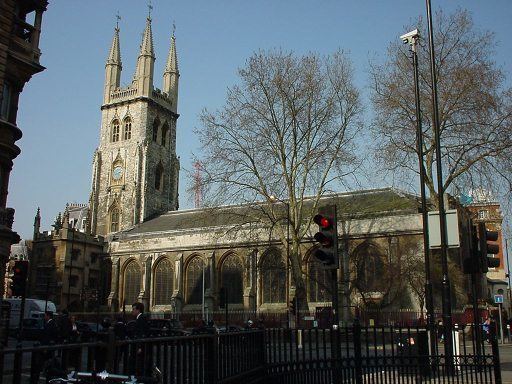Country United Kingdom Founded 12th century | Dedication Edmund the Martyr Phone +44 20 7236 1145 | |
 | ||
Location Holborn ViaductLondonEC1A 2DQ Similar St Sepulchre, St Michael - Cornhill, St Mary Somerset, St Martin - Ludgate, St Mary Abchurch | ||
St Sepulchre-without-Newgate, also known as the Church of the Holy Sepulchre (Holborn), is an Anglican church in the City of London. It is located on Holborn Viaduct, almost opposite the Old Bailey. In medieval times it stood just outside ("without") the now-demolished old city wall, near the Newgate. It has been a living of St John's College, Oxford, since 1622 and is part of the area designated the "Newgate Street Conservation Area" (No.6) by the City of London Corporation.
Contents
History
The original Saxon church on the site was dedicated to St Edmund the (King and) Martyr. In 1137 it was given to the Priory of St Bartholomew. During the Crusades in the 12th century the church was renamed St Edmund and the Holy Sepulchre, in reference to the Church of the Holy Sepulchre in Jerusalem, by soldiers who passed by the church on the way to the Holy Lands. The name eventually became contracted to St Sepulchre.
The church is today the largest parish church in the City. It was completely rebuilt in the 15th century but was gutted by the Great Fire of London in 1666, which left only the outer walls, the tower and the porch standing -. Modified in the 18th century, the church underwent extensive restoration in 1878. It narrowly avoided destruction in the Second World War, although the 18th-century watch-house in its churchyard (erected to deter grave-robbers) was completely destroyed and had to be rebuilt.
The interior of the church is a wide, roomy space with a coffered ceiling installed in 1834. The Vicars' old residence has recently been renovated into a modern living quarter.
During the reign of Mary I in 1555, St Sepulchre's vicar, John Rogers, was burned as a heretic.
The bell
St Sepulchre is named in the nursery rhyme Oranges and Lemons as the "bells of Old Bailey". An account exists which told of a Mr John Dowe, a London merchant, who paid the parish ₤50 to buy a handbell on the condition that it would be rung to mark the execution of a prisoner at the nearby gallows at Newgate. This handbell, known as the Execution Bell, now resides in a glass case to the south of the nave. Between the 17th and 19th centuries, the clerk of St Sepulchre's was responsible for ringing a handbell outside the condemned man's cell in Newgate Prison the night before his execution and announcing the news by repeating the following "wholesome advice":
Given its proximity to both Newgate Prison and the Old Bailey, the bells in its tower, in addition to the usual functions of marking time, were rung to announce executions. On the day of the execution, the bells were tolled as the condemned were led to Tyburn.
Musicians' church
The church has been the official musicians' church for many years and is associated with many famous musicians. Its north aisle (formerly a chapel dedicated to Stephen Harding) is dedicated as the Musicians' Chapel, with four windows commemorating John Ireland, the singer Dame Nellie Melba, Walter Carroll and the conductor Sir Henry Wood respectively. Wood, who "at the age of fourteen, learned to play the organ" at this church and later became its organist, also has his ashes buried in this church.
Military link
The south aisle of the church holds the regimental chapel of the Royal Fusiliers (City of London Regiment) (merged to form the Royal Regiment of Fusiliers), and its gardens are a memorial garden to that regiment. The west end of the north aisle has various memorials connected with the City of London Rifles (the 6th Battalion London Regiment). The church was designated a Grade I listed building on 4 January 1950.
Notable people associated with the church
Organ
The north aisle is dominated by a splendid organ built by Renatus Harris in 1670. The swell was added by John Byfield in c.1730. The organ was enlarged in 1817 by James Hancock and by John Gray in 1828 and 1835, and Gray and Davison in 1849, 1852 and 1855. It was rebuilt in 1932 by Harrison and Harrison. A specification of the organ can be found on the National Pipe Organ Register. It is not currently playable, and an electric organ is used when required for services.
